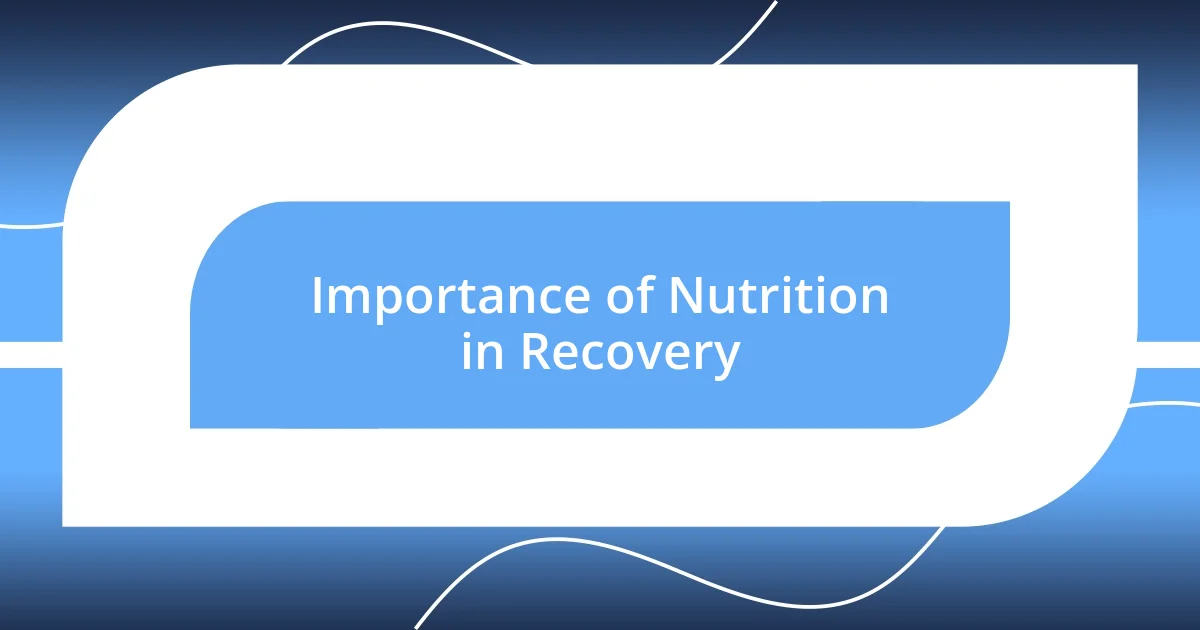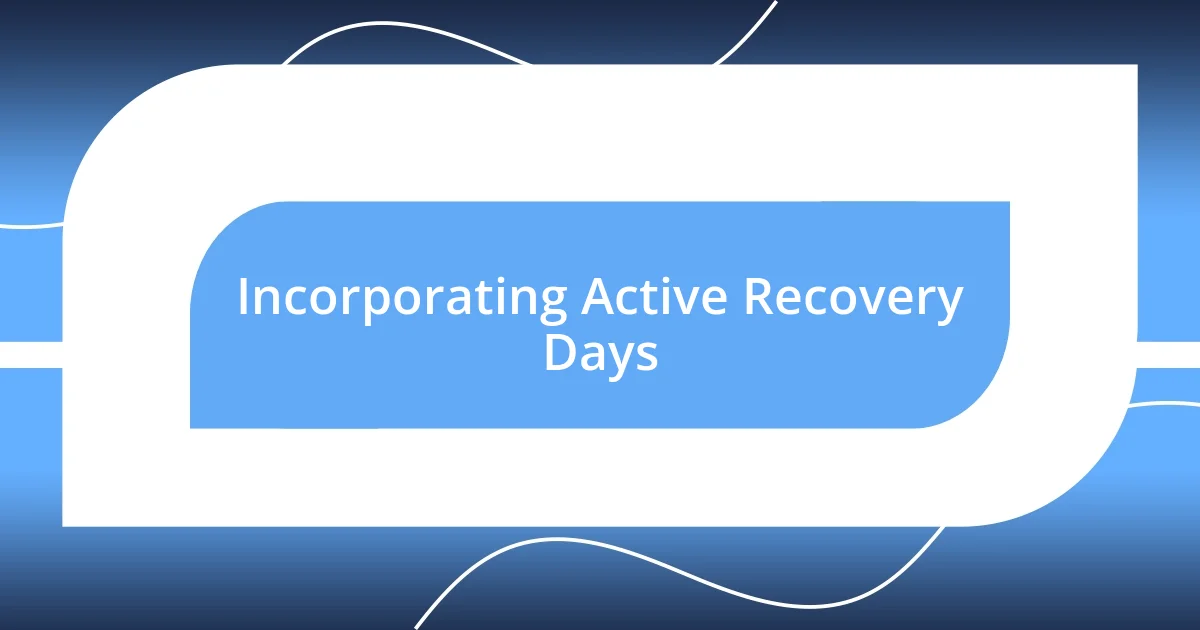Key takeaways:
- Muscle recovery techniques, such as active recovery, nutrition, and foam rolling, are essential for enhancing physical and mental performance post-workout.
- Nutrition is crucial; consuming protein and other nutrients shortly after exercise significantly aids in muscle repair and increases energy levels.
- Incorporating active recovery days can improve wellness and mental clarity, highlighting that recovery doesn’t have to mean complete rest.

Understanding Muscle Recovery Techniques
Muscle recovery techniques can vary widely, but I’ve found a few approaches that genuinely enhance my recovery process. For instance, after a grueling workout, I often treat myself to a warm Epsom salt bath. Not only does it soothe my aching muscles, but it also provides that rare moment of quiet reflection I desperately need after an intense training session. Have you ever noticed how something as simple as soaking in warm water can melt away stress and tension?
One essential aspect I’ve learned is the importance of active recovery, such as light yoga or gentle stretching. I remember one particularly taxing week where I pushed myself a bit too hard. Instead of collapsing on the couch, I opted for a slow-paced yoga session. The gentle movements helped release some of that tension and surprised me with how much better I felt afterward. It’s a reminder that sometimes, doing a little less can be just what your body craves.
Nutrition also plays a pivotal role in muscle recovery, and I’ve come to see it as an ally rather than just fuel. After one of my toughest workouts, I experimented with a protein smoothie infused with spinach and banana. The vibrant colors in my drink brought a smile to my face and, surprisingly, gave my body just what it needed to bounce back. What have you tried incorporating into your post-workout meals? It’s fascinating to see how something as enjoyable as a smoothie can bridge the gap between hard work and recovery.

Importance of Nutrition in Recovery
Nutrition is crucial in muscle recovery, and I’ve realized it can significantly impact how quickly I bounce back after intense workouts. For instance, I once skipped a post-workout snack, thinking I’d manage just fine. By the next training session, I felt unusually sluggish and less motivated. That experience taught me that fueling my body appropriately isn’t just a choice; it’s essential for maintaining performance and getting through my fitness routine.
I’ve found that incorporating lean protein, healthy fats, and carbs into my meals makes a world of difference. After a tough leg day, I often whip up a quinoa bowl topped with grilled chicken and avocado. The way my body responds to that wholesome meal is incredible—I can literally feel the energy returning. Have you ever noticed how what you eat after training can shift your entire mindset for the days to come? It’s as if the right nutrients act as a little confidence booster, encouraging me to tackle my next workout with vigor.
The timing of nutrition also plays a role in recovery. I’ve read about the golden hour where consuming protein shortly after exercise can help repair those tiny muscle tears. I aim to grab a protein-rich snack within 30 minutes post-workout, whether it’s a handful of nuts or even a protein bar. Reflecting on my journey, I’ve noticed that paying attention to nutrition not only accelerates recovery but also brings a sense of discipline and routine to my training. It’s rewarding to feel my body heal and strengthen with every careful choice I make.
| Nutrition Component | Benefits for Recovery |
|---|---|
| Protein | Helps repair and build muscle tissue. |
| Healthy Fats | Reduces inflammation and supports hormone production. |
| Carbohydrates | Replenishes glycogen stores for energy. |

Effective Stretching and Foam Rolling
Stretching and foam rolling have become vital parts of my recovery routine, and I can honestly say they work wonders for my body. I vividly recall a morning after an intense workout where I felt every muscle fiber protesting as I rolled out of bed. That’s when I decided to spend some time with my foam roller. As I methodically worked on tight spots, it was as if the tension released with each gentle roll. There’s something almost meditative about it; I find myself letting go of stress while focusing on my breath, creating a calm space in my busy day.
When it comes to effective techniques, here’s what I recommend based on my experience:
- Dynamic Stretching Before Workouts: This type of stretching warms up muscles and increases range of motion, preparing the body for action.
- Static Stretching After Workouts: I like to hold stretches for at least 20-30 seconds to ensure my muscles are adequately lengthened and relaxed.
- Regular Foam Rolling Sessions: Following my workouts, I spend about 10-15 minutes rolling out tight areas like my quads and hamstrings. It’s like giving my muscles a personalized massage that helps prevent soreness.
- Listening to My Body: I’ve learned to pay attention to what feels tight or sore. If I find a particularly problematic area, I focus on that spot a little longer to really ease the tension.
- Consistency Is Key: I try to incorporate both stretching and foam rolling into my weekly routine—sometimes even on rest days—to maintain flexibility and promote recovery.
By sharing my journey with stretching and foam rolling, I hope to encourage you to explore these techniques. They’ve made a measurable difference in how I recover, reducing discomfort and enhancing my mobility.

Benefits of Sleep for Recovery
Sleep has been a game changer for my recovery. I used to underestimate its impact, but after a week of poor sleep, I found myself dragging through my workouts like a zombie. It was then that I realized: inadequate rest not only affects my physical strength but also my mental clarity and motivation. Have you ever noticed how a good night’s sleep can change everything? It’s incredible how those few hours can restore my energy and drive me to push harder during my next session.
During sleep, our bodies engage in vital processes, like muscle repair and growth. I often wake up feeling refreshed after a solid 7-9 hours, knowing that my muscles have been hard at work while I rest. There’s something reassuring about the science behind it—growth hormone rises at night, promoting the recovery of muscles that endure stress during workouts. I remember one morning, reflecting on my training intensity and realizing that the nights I prioritized sleep, my performance soared.
What’s intriguing is how sleep can influence my mood, too. After those restorative nights, I step into the gym with a better mindset, which makes all the difference. I’ve even started tracking my sleep patterns and discovered that quality sleep doesn’t just happen by chance. Maintaining a consistent routine and creating a calming bedtime ritual has genuinely enhanced my recovery journey. So, what about you—what changes have you noticed in your training when you ensure those precious hours of sleep? It’s a simple yet effective aspect of recovery that I now actively prioritize.

Hydration Strategies for Muscle Repair
Staying properly hydrated is like giving my muscles the fuel they need for recovery. I noticed a noticeable difference after I made hydration a priority. There was a time when I would focus solely on my workouts without paying much attention to water intake. But now, I carry a water bottle everywhere, sipping consistently throughout the day. Have you ever experienced that mid-workout fatigue that just doesn’t seem to lift? I realized that for me, staying hydrated transformed those sluggish sessions into energetic achievements.
Incorporating electrolyte-rich drinks, especially after a tough workout, has become essential for my recovery strategy. I remember one particularly brutal leg day; I was definitely left feeling drained. I opted for a coconut water post-session, and it felt like an instant revival. That natural boost in electrolytes helped replenish what I lost through sweat, making a world of difference in how I felt the next day. It’s funny how a small change like this can turn around your energy levels overnight, wouldn’t you agree?
I’ve also learned to listen to my body when it comes to hydration. Sometimes, I crave a refreshing herbal tea after a long gym session, and those moments remind me of the importance of variety. Hydrating doesn’t have to be boring; it can be an enjoyable part of my recovery routine. Recently, I tried a homemade fruit-infused water, combining lemon and mint, and I found myself looking forward to that refreshing taste. How do you mix up your hydration strategies? Keeping things interesting helps me stay committed to my recovery goals.

Incorporating Active Recovery Days
Incorporating active recovery days into my routine has been a game changer for my overall wellness. I used to think that more workouts equated to better results, but after pushing my limits too far, I realized I needed a break to recharge. One day, feeling particularly sore, I decided to trade my typical gym session for a light yoga class. It felt refreshing to move my body gently while still being active, and surprisingly, I left the class feeling more energized than I had anticipated. Have you ever found yourself bouncing back stronger after a day off?
I also love to use my active recovery days as an opportunity to explore new activities, like hiking or cycling at a comfortable pace. Recently, I took a scenic bike ride through a local park, soaking in the fresh air and natural beauty, and I couldn’t believe how much my mood lifted. There’s something magical about connecting with nature while still allowing my muscles to recover. It makes me appreciate my fitness journey even more, knowing that recovery doesn’t have to mean complete rest. How do you mix it up when it comes to your active recovery?
What I’ve come to appreciate is how active recovery enhances my mental clarity, too. One day, during a gentle stretch session at home, I found my mind drifting to creative ideas I couldn’t access during high-intensity workouts. It was almost meditative; I realized that I wasn’t just aiding my muscles but also nourishing my mind. Incorporating these days has truly taught me that recovery can be just as versatile as training itself. Do you ever find inspiration during your recovery activities?

Tracking Progress and Adjusting Methods
Tracking my progress in muscle recovery is essential to understanding what really works for me. I keep a simple journal where I note the intensity of my workouts, how I feel afterward, and any changes in my recovery methods. Looking back, I noticed that after introducing foam rolling to my routine, I felt less soreness the following days. Have you ever taken the time to keep a log? It can be quite eye-opening and encourages me to make informed adjustments.
Adjusting my methods is an ongoing process that sometimes requires a leap of faith. For instance, I decided to experiment with incorporating a post-workout protein shake after a friend raved about its benefits. After a week, I noticed I bounced back faster and had more energy during my subsequent workouts. It was a small tweak, but it made me think: what simple changes in your routine might lead to noticeable improvements?
One thing I’ve learned is to be flexible with my approach. Last month, I hit a plateau, feeling stagnant both physically and mentally. So, I decided to switch things up and try a new recovery technique—contrast baths. The initial discomfort gave way to a refreshing sense of invigoration, and my body responded well! This taught me that recovery isn’t a one-size-fits-all journey; it’s all about listening to yourself and being willing to adapt. Have you found any surprising methods that work wonders for you?












